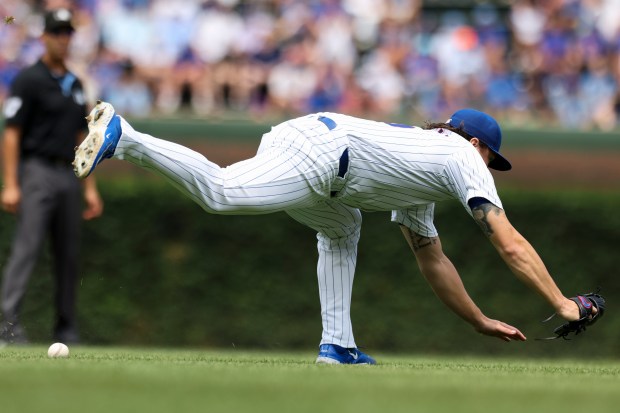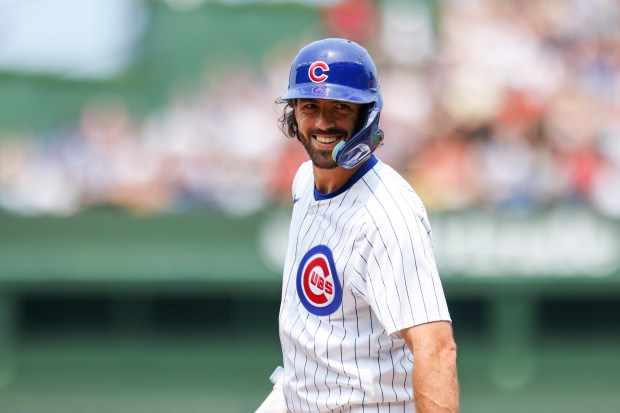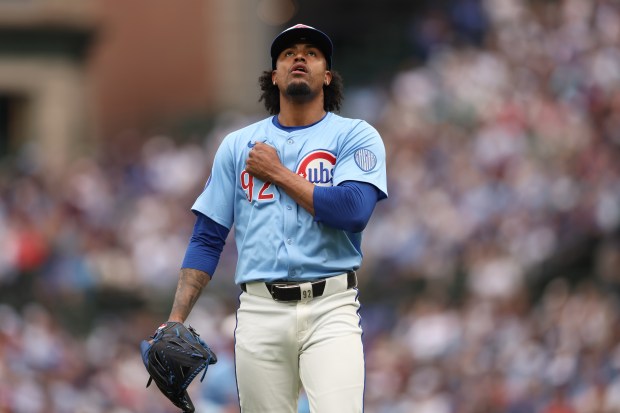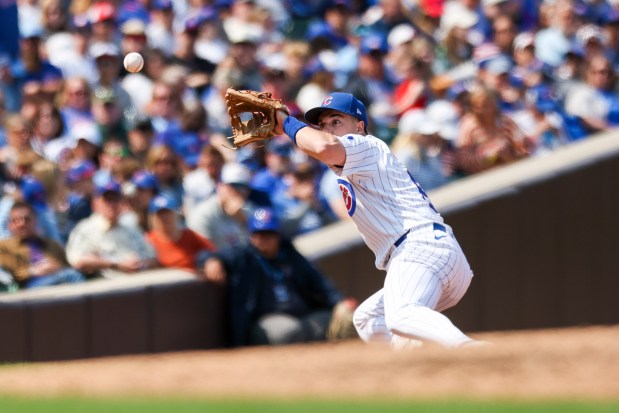Jed Hoyer’s White Flag submission won’t go down in Chicago sports history like White Sox Chairman Jerry Reinsdorf’s memorable quote about his team’s White Flag trade in 1997.
“Anyone who thinks we can catch Cleveland is crazy,” Reinsdorf told Chicago Sun-Times reporter Toni Ginnetti after the deadline deal of three veteran pitchers to the San Francisco Giants for prospects.
The 1997 the Sox were only 3½ games back of first-place Cleveland in the American League Central, and Reinsdorf’s surrender with two months left outraged fans and players alike.
Upon arriving in San Francisco, closer Roberto Hernández said Sox fans “probably want (Reinsdorf’s) head on a platter.” Starter Danny Darwin, who also went to the Giants, said: “What can you say when you have an owner who doesn’t believe you can catch Cleveland?”
The Cubs, likewise, were only 3½ back for the last spot in the National League Wild-Card race Monday when Hoyer gave up on improving the 2024 team.
But Hoyer was smart enough not to go viral, dropping cryptic phrases such as “you are what your record says you are” while pointing out the obvious — the Cubs would not seek rentals. It’s not so much a traditional White Flag as a virtual White Flag.
“Where we are right now … unless things change over the next week, we probably won’t do a lot of moves that only help us for this year,” Hoyer said. “If moves help us for ’25 and beyond, I think we’re still exceptionally well positioned, that’s where our focus will be. But like just helping in ’24, that probably won’t be our focus unless things change dramatically.”
That’s a long way of saying “anyone who thinks we can catch the rest of the NL wild-card teams is crazy.”
The sad part, for Cubs fans, is that Hoyer is probably right, except for the part about being “exceptionally well positioned” for next year. There’s no point in trying to add to this team for a futile wild-card bid when the Cubs already have shown a complete inability to go on a prolonged winning streak. The impressive three-game sweep in Baltimore from July 7-9 turned out to be a blip, not a trend.
Things haven’t changed dramatically in the three days since Hoyer’s pronouncement, and on Friday the Cubs begin a trip to Kansas City, Mo., and Cincinnati with the July 30 deadline clock ticking.
Reasonable Cubs fans, if that’s not an oxymoron, readily accept Hoyer’s decision to shrug off the rest of 2024. Even those who would like someone besides Hoyer making the big decisions on how to proceed in 2025 know the handwriting is on the wall.
We’ve all watched some bad Cubs teams in our lives, but recalling a more boring one over the last six decades is a real challenge. Before Wednesday’s 3-2 loss to the Milwaukee Brewers, only three teams had fewer home runs in their home ballpark than the Cubs’ 46. The team’s .227 home batting average and .364 slugging percentage at Wrigley both ranked third-worst in the majors.
It’s so uninteresting that Marquee Sports Network brought beloved former Cub Jon Lester into the TV booth to boost ratings, like a sagging sitcom bringing in a “special guest” such as Paul Rudd for sweeps week.
But Lester’s low-key cameos didn’t make much of an impression. As analysts go, he’s no David Ross. In fact the only one who could really make Cubs games more interesting would be Ross joining Boog Sciambi and Jim Deshaies to offer critiques on Craig Counsell’s moves.
Hoyer’s tenure as president of baseball operations, now in Year 4, has yet to produce tangible results in what supposedly is a results-driven business. But there is nothing to suggest Chairman Tom Ricketts will look elsewhere, so we’ll have to take it on faith that Dansby Swanson’s next five years will be better and Pete Crow-Armstrong is not the next Albert Almora Jr. and the Cubs are “well positioned” for better things next year.
Hoyer didn’t say the Cubs would be sellers, though he probably has to trade at least one or two “name” players just to prove he’s trying something different. Taking a page out of the Artūras Karnišovas playbook and standing pat for another year would be the worst thing Hoyer could do. That means everyone should be available — except for Justin Steele, the heart and soul of the team.

In a stroke of good fortune, reliever Héctor Neris has been pitching well of late — though he gave up the go-ahead run in the top of the ninth inning Wednesday and took the loss — giving Hoyer an out from a signing that backfired when he pitched so poorly in May and June he lost the closer’s role. Neris’s deal includes a $9 million option for 2025 that becomes a player option if he appears in 60 games. Neris made his 38th appearance Wednesday, so the magic number is 21 for any club interested in adding a heart-attack-inducing specialist for the stretch run.
Jameson Taillon also has drawn interest and would be one of the more desirable starters on the market if he weren’t owed $36 million over the next two years. Still, Hoyer should get what he can for Taillon since he couldn’t trade the injured Marcus Stroman last summer and then got nothing in return when Stroman opted out.
Ian Happ might be convinced to waive his no-trade clause for a chance to play on a true contender, and Kyle Hendricks deserves one more postseason. Cody Bellinger already left the Cubs once, so one more goodbye wouldn’t be too difficult.
If Counsell is the manager the Cubs truly believe he is, he should have no problem letting prospects such as Alexander Canario, Matt Shaw, Owen Caissie and Moises Ballesteros come up and play down the stretch. Crow-Alexander has been given ample opportunity to prove he can hit. Why shouldn’t the others?
The Cubs are always touchy about using the word “rebuild,” so showcasing kids in the final two months might have to be branded as “repurposing” the roster. Either way, if their farm system is as good as hyped, it would be nice to see some of the better prospects playing here in August and September instead of waiting until meaningless Cactus League games in March.
As Theo Epstein would say, “If not now, when?”





